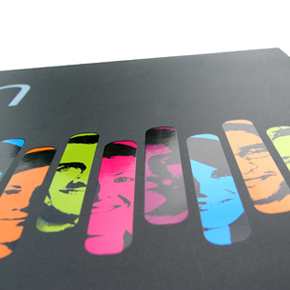Level of sales in the printing business based on UV technology has increased globally three times compared to the competition from conventional offset.
Because UV varnishes does not contain harmful organic solvents they are use more and more especially in the U.S. from the economic and from environmental reasons.
This technology offers high gloss of printed materials and increases the range of printing surfaces who can be used and therefore is used particular in order for achieving better design and improving the selling of graphic products.
UV technology represents the biggest degree of quality, and when is used in inline, process is efficient, consistent and just as harmless as the conventional offset printing in terms of health if we follow all the instructions and measures of safety.
However, it is not possible to overcome UV printing and coating technology in a simply steeps.
UV printers need to collect experience, manage expenses of investment and expenses of materials and energy, they must plan time of amendments and preparation time for machine between operations with conventional and UV colors, as well as to adjust printing parameters.
With UV varnish can be achieved excellent effects and high shine of printed material.
Besides that printed materials varnished with UV coatings have a much better and smoother fingerprints touch.
UV Technology- Principle of Operation
For creating dry coated film on printed material UV varnish are using UV radiation from which their name is coming.
They consist of a fluid resin and their derivatives, additives, and photo initiators.
Because they don’t contain liquid substances the whole amount of varnish will polymerized as a hard film on the surface of printed material. Photo initiators will let start-up reaction of connecting of molecules like in the net under the influence of UV radiation .UV varnishes without the effects of UV radiation remain in fluid and therefore will not get dry on the rollers.
Net connection can be radical or cationic.
Radical is at the inks and varnishes based on acrylic and these are mainly used UV varnishes.
It is necessary to bring the energy of radiation during the whole process of drying.
Drying is carried out in a manner that photo initiators under the influence of UV radiation decompose into chemically highly reactive radicals that initiate networking of monomers in a strong plastic film.
For more expensive, cationic substances, which are mainly UV varnishes based on epoxy resin, a one single pulse is enough to trigger the process of drying i.e. networking, which can then only spend up to the end.
Since UV inks and varnishes harden in a split second using UV radiation in the printing press, sheet can be instantly forwarded to next process of post press operations and film thickness shows high resistance to mechanical influences such as the scraping and scratching.
Generally UV varnishes have a lot of advantages.
For example, on inline UV coating on UV inks is not necessary to use powder.
In cases where the UV-varnish is applied over the conventional offset ink on which first is printed primer is required in to examine the need for the use of powder.
But their biggest plus is the possibility of printing on non-porous substrates such as synthetic, plastics or metallic papers.
Huge range of non-absorbent substrates that can be printed with UV inks and varnishes becomes great challenge for creative designers in print of packaging and labels.
Check at NuWave Printing printing supplier with great reputation and choose something from their great pallete of printed products.
There are still place for improvement of this technology in the form of odor of UV prints.
Also, because of aggressive photo initiator in these inks must be careful not to come in contact with skin and especially not to put them under the sun because UV radiation stimulates reaction.
But the advantages far outweigh the disadvantages of this UV technology.
If we talk about the disadvantages, then they are essentially costs of investments in this technology that is the high and high costs of materials and energy, because UV lamp consumes large amounts of electricity.


